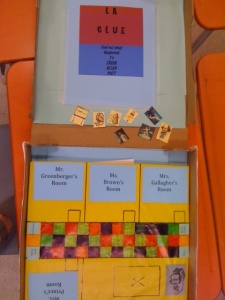I’m sure you’ve heard the cliché that kids are sponges that soak up everything they see and hear. You might be especially familiar with this cliché if you have children of your own because you may have had to curb your swearing after your beautiful baby girl-turned toddler yelled “damn it” when she dropped her pudding. Language acquisition is fascinating with amazing statistics about how your five-year-old can genuinely absorb something like twenty new words every day; that’s over 7,000 words in a single year. Unsurprisingly, that number declines rapidly as we age, in part because we don’t hear twenty new words each day and in part because we aren’t all Sheldon from The Big Bang Theory with infinite storage in our brains. I’ve read that at the middle school level, my students can still genuinely learn eight new words each week, but to do that, they need to hear the words, see the words, use the words, and create meaning with the words, as if they were five. That’s why they pay me the big bucks, and perhaps at a later time, I’ll reveal my secrets for how I accomplish that learning feat.
But language acquisition isn’t really what I wanted to discuss. I am continually reminded of the sponge metaphor even though my students are young adults because in a way we’re all still sponges. Who among us hasn’t heard a fantastic joke on TV or in person and retold it to a group of friends? Who can’t retell a particularly awesome scene of a movie or thrilling play their favorite sports team pulled off? We see things, and part of our brain changes, maybe ever so slightly, but I think it does change.
And that’s one reason I have museum days in my class, days that I adore and part of the reason teaching middle school is preferable to any other level. When I assign a project, I don’t want to be the lone audience, but creating an audience of peers can be difficult. So, the day any project is due, all students display their work in the classroom and the entire period is spent in a scavenger hunt that requires all students to look at their classmates’ work. Bam, genuine audience of peers. Knowing that their classmates are going to peruse their work means that I no longer get crayon designs and a single piece of tape holding everything together. If I taught younger students, I doubt they would care as much if their classmates liked their work; they seem to be teacher-pleasers in the elementary schools.
Reason 2 that I love museum days is that it allows students to absorb in their sponge-like ways their classmates’ creative ideas. I know that there are parents who “help” too much, but regardless, by seeing what is possible, my students are often motivated to push themselves further on the next project and to emulate the best in the class. When everyone has the same assignment, but everyone ends up with such different final products, students see that there are many ways to interpret and to accomplish the same goal, and I watch it drive their creativity on subsequent projects. At a younger level, I’m not sure if the balance of student-parent work would be equal enough to merit spending class time to examine, and even if it were balanced, the students are too young to notice creative differences or to learn from them.

Students do textual analysis for one topic in a Shakespeare play. Displayed around the room in ABC order for Museum Day.
Reason 3 that I love museum days is that I design the scavenger hunt to act as a review for the unit’s content. If we are studying Shakespeare, students look at their classmates’ projects to find facts that I will be testing; they have to find the answer and cite which project gave them the answer. They enjoy looking at their friends’ work, and I know that they are reviewing important content while engaged. If I taught high school, such a class activity would probably seem juvenile. What sixteen-year-old wants to find an example of personification in a classmate’s poem? But if I call it a “scavenger hunt,” my thirteen-year-old students are instantly tricked and forget that they are doing work.
And the final reason that I love museum days is it makes grading much easier. I’m a pretty busy person and projects are usually bulky and impossible to take home to grade. While my students are on their scavenger hunt, enjoying the creative work they see, I am grading. If you design a good enough rubric, you can quickly evaluate the level of success each project attains. In a forty-minute period, I can usually grade between fifteen and twenty projects. I am not carting home giant posters or scrapbooks or dioramas; I am evaluating during the class period and saving myself hours of work.
Now that I’ve convinced you that museum days are the best for students and teachers, let me share some of the brilliant ideas my students have showcased so you can see why I love teaching eighth grade. I had a student build a refrigerator out of cardboard, with trays in the doors and everything to display his work. I had a student engineer a flag to project from the center of his project with string while still allowing for the project to lay flat for transportation. I’ve seen duct tape used in every possible way you could imagine, to decorate backgrounds, to create 3-D people and objects, to outline, for barbed wire; the uses of duct tape are truly endless. Students have melted crayons and attached the remaining half crayon as well as used the melted wax as a drizzled decoration. Projects that collapse often have door handles to open them (and by door handles I mean drink bottles, rope, pine cones, and anything else you could hold and pull). There are flashing lights with on-off switches and music that plays because the student ripped out the inside of a signing card. There are pop-ups and pull-outs and even a pack of tissues attached to one project in case it made me cry.

LA Clue: What Happened to Edgar Allan Poe? Students created a “Clue” style board game with a layout of our school. The “players” are various authors including Shakespeare.
It’s important to share with you the trials I’ve faced in my classrooms and my frustrations, but I need you to see the beauty of being thirteen as well. I need you to see this tender balance between childhood, sponge-like absorbing of knowledge and adult creativity and brilliance. This must be one of the few times in a person’s life when they can still learn like a child but start learning what adults should know, not yet jaded, still impressionable. Museum days make me feel like I make a difference.


